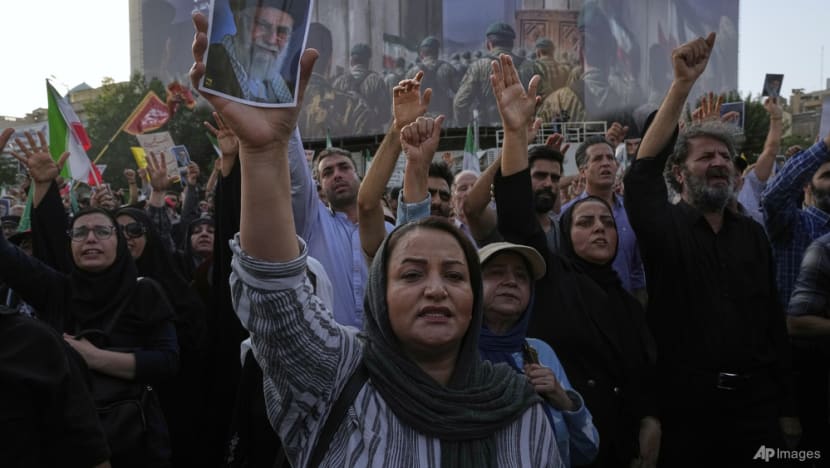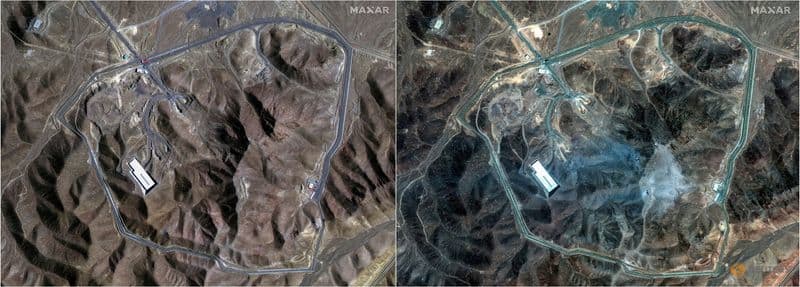Commentary: Iran has no good choices to respond to US strikes – only the best of bad options
The US strikes on Iran were intended as a one-time effort. Whether it stays that way is up to Iranian leaders’ choices in the coming days, says Carl Skadian of the NUS Middle East Institute.

Protesters chant slogans as one of them holds up a poster of the Iranian Supreme Leader Ayatollah Ali Khamenei in a protest following the US attacks on nuclear sites in Iran, on Jun 22, 2025. (AP Photo/Vahid Salemi)

This audio is generated by an AI tool.
SINGAPORE: In the end, it was the American president who appeared to be the most dead set against “stupid, endless wars” in the Middle East that sent the nation’s military back into the region in a purely offensive manner.
Although expectations were raised that the United States could act against Iran, the attacks early on Sunday (Jun 22) were a surprise – at least in terms of timing. Donald Trump gave Iran two weeks to come to a decision on whether it wanted to return to the negotiating table. Instead, he took all of two days to strike.
Whether the two-week window was a ruse, or whether the US leader had gained new intelligence about Iran’s unwillingness to negotiate – or even whether Mr Trump had already decided to attack when he set the deadline – will likely be unknown for some time, if ever.
Another big unknown is how successful the American attacks were in setting back Iran’s nuclear programme. Mr Trump claimed that Iran’s nuclear facilities had been “completely and totally obliterated”.

But the press conference on Sunday night by the Pentagon provided neither detailed battle damage assessments nor satellite imagery that could shed light on the success of Operation Midnight Hammer beyond the superlatives employed by Mr Trump.
Details will surely be clearer to the White House, but whether the message has been received by Tehran remains an open question.

IRAN HAS NO GOOD CHOICES
Perhaps what was most significant about the president’s remarks was what was not explicitly stated: The US action was intended as a one-time effort, and whether it stays that way is up to the leadership of the Islamic Republic.
That, of course, hinges on two things: Whether the bomb and missile strikes were as effective as claimed, and how Iran will respond to them.
On the former, a successful mission is a preferable outcome: It increases the chances that calm will return sooner, rather than later – because Iran has no good choices.
If, as threatened, it decides that the only way forward for it is to exit the Nuclear Non-Proliferation Treaty (NPT) and take its programme underground, this will likely invite more American, and Israeli, action as they seek to exploit a moment of extraordinary Iranian weakness and vulnerability.
This is a trail that has been blazed by North Korea, which is now estimated to have about 60 nuclear weapons. Washington will have no doubt learned lessons from its failure to keep Pyongyang from breaking out.
Then again, the kinetic options that were available to the US in Iran were never really on the table in the case of North Korea, despite threats from a succession of US presidents – Mr Trump himself warned of “fire and fury like the world has never seen”.
The risks of a dramatic escalation, geopolitical uncertainty and lack of solid intelligence were among the reasons the US did not draw a firm line in the sand, and allowed North Korea to call its bluff. When it comes to Iran, the line has been drawn, and the consequences for crossing it have been clearly spelled out.
DOING NOTHING WOULD BE CAPITULATION
As Mr Trump put it, there will either be peace or tragedy for Iran, and the choice is theirs.
Beyond the missile salvo it launched on Israel hours after the US strikes, Iran could hit American bases and the 40,000 troops in the Middle East as retaliation. It could also lash out by attempting to close the Strait of Hormuz, crippling oil supplies and attack Gulf Arab states, as it has done in the past. It could also resort to cyberattacks, or terrorist actions against US and Israeli interests around the world.
But that is inviting further trouble on itself. The US attacks on Fordow, Natanz and Isfahan, Mr Trump claimed, were the “most difficult” for the military to carry out, and that future ones would be “a lot easier”. For good measure, he added a footnote: “Remember, there are many targets left.”

In its current weakened and exposed state, any action Iran takes to widen the conflict will make its position even more precarious.
That said, Iran cannot be expected to do nothing. Standing idly by would be tantamount to announcing its humiliating capitulation to the world.
For the regime, much worse could follow: Doing nothing would validate an idea that many Iranians themselves believe – that their leaders have led them down a reckless path that has brought them economic misery, international opprobrium and isolation from the world.
Iranians are a proud people and will rally around the flag in the face of severe attacks, setting aside political and ideological differences despite all their misgivings. An unconditional surrender, however, will force them to look inward at the choices that brought them here, and begin a reckoning against the clerical regime.
WHAT’S THE BEST OF BAD OPTIONS?
That leaves Iran the best of bad options – one it has taken before.
In 2020, during Mr Trump’s first term, it took five days after the US assassination of Islamic Revolutionary Guard Corps leader Qassem Soleimani before Iran retaliated. It fired more than a dozen ballistic missiles at US bases in Iraq.
Before it pressed the trigger, however, Tehran telegraphed the attacks, allowing Americans to seek safety. This prevented US fatalities, although more than 100 troops suffered traumatic brain injuries.
This would appear to be the best course forward. Iran can claim retaliation in force, both sides can then put a lid on this episode and then sit down to work out a lasting solution.
An agreement on the terms of Iran’s surrendering of its nuclear ambitions – without ever using that word – may then be worked out, allowing all sides to claim some wins, and climb down from the escalatory ladder.
Then again, in the Middle East, there are exceedingly few who have been accused of being rational actors.
Carl Skadian, a former journalist and editor for 30 years, is deputy director at the Middle East Institute, National University of Singapore.


















